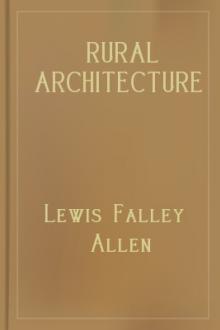Rural Architecture by Lewis Falley Allen (accelerated reader books .txt) 📖

- Author: Lewis Falley Allen
- Performer: -
Book online «Rural Architecture by Lewis Falley Allen (accelerated reader books .txt) 📖». Author Lewis Falley Allen

FLOOR PLAN.
INTERIOR ARRANGEMENT.Entering the large door, (a,) at the front end, 14 feet wide, and 14 feet high, the main floor (g,) passes through the entire length of the barn, and rear lean-to, 116 feet—the last 16 feet through the lean-to—and sloping 3 feet to the outer sill, and door, (a,) of that appendage. On the left of the entrance is a recess, (e,) of 20×18 feet, to be used as a thrashing floor, and for machinery, cutting feed, &c., &c.—5 feet next the end being cut off for a passage to the stable. Beyond this is a bay, (b,) 18×70 feet, for the storage of hay, or grain, leaving a passage at the further end, of 5 feet wide, to go into the further stables. This bay is bounded on the extreme left, by the line of outside posts of the barn. On the right of the main door is a granary, (d,) 10×18 feet, two stories high, and a flight of steps leading from the lower into the upper room. Beyond this is another bay, (b,) corresponding with the one just described on the opposite side. The passages at the ends of the bays, (e, e,) have steps of 3 feet descent, to bring them down on to a level with the stable floors of the lean-to. A passage in each of the two long side lean-to's, (e, e,) 3 feet wide, receives the hay forage for cattle, or other stock, thrown into them from the bays, and the lofts over the stables; and from them is thrown into the mangers, (h, h.) The two apartments in the extreme end lean-to, (f, f,) 34×16 feet each, may be occupied as a hospital for invalid cattle, or partitioned off for calves, or any other purpose. A calving house for the cows which come in during the winter, is always convenient, and one of these may be used for such purpose. The stalls, (i, i,) are the same as described in Design I, and back of them is the passage for the cattle, as they pass in and out of their stalls. The stable doors, (j, j,) are six in number. Small windows, for ventilation, should be cut in the rear of the stalls, as marked, and for throwing out the manure, with sliding board shutters. This completes the barn accommodation—giving twenty-eight double stalls, where fifty-six grown cattle may be tied up, with rooms for twenty to thirty calves in the end stables. If a larger stock is kept, young cattle may be tied up, with their heads to the bays, on the main floor, beyond the thrashing floor, which we practice. This will hold forty young cattle. The manure is taken out on a wheel-barrow, and no injury done to the floor. They will soon eat out a place where their forage can be put, and do no injury beyond that to the hay in the bays, as it is too closely packed for them to draw it out any farther. In this way we can accommodate more than a hundred head of cattle, of assorted ages.
The hay in the bays may drop three feet below the level of the main floor, by placing a tier of rough timbers and poles across them, to keep it from the ground, and many tons of additional storage be thus provided. We have often stored one hundred and fifty tons of hay in this barn; and it will hold even more, if thoroughly packed, and the movable girts over the main floor be used, as described in Design I.
The chief advantages in a barn of this plan are, the exceeding convenience of getting the forage to the stock. When the barn is full, and feeding is first commenced, with a hay knife, we commence on each side next the stables, on the top of the bays, cut a well down to the alley way in front of the mangers, which is left open up to the stable roof. This opens a passage for the hay to be thrown into the alleys, and in a short time it is so fed out on each side, that, the sides of the main barn being open to them, the hay can be thrown along their whole distance, and fed to the cattle as wanted; and so at the rear end stables, in the five-foot alley adjoining them. If a root cellar be required, it may be made under the front part of the main floor, and a trap-door lead to it. For a milk dairy, this arrangement is an admirable one—we so used it for four years; or for stall-feeding, it is equally convenient. One man will do more work, so far as feeding is concerned, in this barn, than two can do in one of almost any other arrangement; and the yards outside may be divided into five separate inclosures, with but little expense, and still be large enough for the cattle that may want to use them. It matters not what kind of stock may be kept in this barn; it is convenient for all alike. Even sheep may be accommodated in it with convenience. But low, open sheds, inclosed by a yard, are better for them; with storage for hay overhead, and racks and troughs beneath.
This barn is built of wood. It may be well constructed, with stone underpinning, without mortar, for $1,000 to $1,500, as the price of materials may govern. And if the collection of the water from the roofs be an object, cheap gutters to carry it into one or more cisterns may be added, at an expense of $200 to $300.
As before observed, a barn may be built on this principle, of any size, and the stables, or lean-to's may only attach to one side or end; or they may be built as mere sheds, with no storage room over the cattle. The chief objection to stabling cattle in the body of the barn is, the continual decay of the most important timbers, such as sills, sleepers, &c., &c., by the leakage of the stale, and manure of the cattle on to them, and the loss of so much valuable storage as they would occupy, for hay and grain. By the plan described, the stables have no attachment to the sills, and other durable barn timbers below; and if the stable sills and sleepers decay, they are easily and cheaply replaced with others. Taking it altogether, we can recommend no better, nor, as we think, so good, and so cheap a plan for a stock barn, as this.
We deem it unnecessary to discuss the subject of water to cattle yards, as every farm has its own particular accommodations, or inconveniences in that regard; and the subject of leading water by pipes into different premises, is too well understood to require remark. Where these can not be had, and springs or streams are not at hand, wells and pumps must be provided, in as much convenience as the circumstances of the case will admit. Water is absolutely necessary, and that in quantity, for stock uses; and every good manager will exercise his best judgment to obtain it.
BARN ATTACHMENTS.It may be expected, perhaps, that in treating so fully as we have of the several kinds of farm building, a full cluster of out-buildings should be drawn and exhibited, showing their relative positions and accommodation. This can not be done, however, except as a matter of "fancy;" and if attempted, might not be suited to the purposes of a single individual, by reason of the particular location where they would be situated, and the accommodation which the buildings might require. Convenience of access to the barns, from the fields where the crops are grown, a like convenience to get out manures upon those fields, and a ready communication with the dwelling house, are a part of the considerations which are to govern their position, or locality. Economy in labor, in the various avocations at the barn, and its necessary attachments; and the greatest convenience in storage, and the housing of the various stock, grains, implements, and whatever else may demand accommodation, are other considerations to be taken into the account, all to have a bearing upon them. Compactness is always an object in such buildings, when not obtained at a sacrifice of some greater advantage, and should be one of the items considered in placing them; and in their construction, next to the arrangement of them in the most convenient possible manner for their various objects, a due regard to their architectural appearance should be studied. Such appearance, where their objects are apparent, can easily be secured. Utility should be their chief point of expression; and no style of architecture, or finish, can be really bad, where this expression is duly consulted, and carried out, even in the humblest way of cheapness, or rusticity.
We have heretofore sufficiently remarked on the folly of unnecessary pretension in the farm buildings, of any kind; and nothing can appear, and really be more out of place, than ambitious structures intended only for the stock, and crops. Extravagant expenditure on these, any more than an extravagant expenditure on the dwelling and its attachments, does not add to the selling value of the farm, nor to its economical management, in a productive capacity; and he who is about to build, should make his proposed buildings a study for months, in all their different requirements and conveniences, before he commences their erection. Mistakes in their design, and location, have cost men a whole after life of wear-and-tear of temper, patience, and labor, to themselves, and to all who were about them; and it is better to wait even two or three years, to fully mature the best plans of building, than by hurrying, to mis-locate, mis-arrange, and miss, in fact, the very best application in their structure of which such buildings are capable.
A word might also be added about barn-yards. The planning and management of these, also, depends much upon the course the farmer has to pursue in the keeping of his stock, the amount of waste litter, such as straw, &c., which he has





Comments (0)